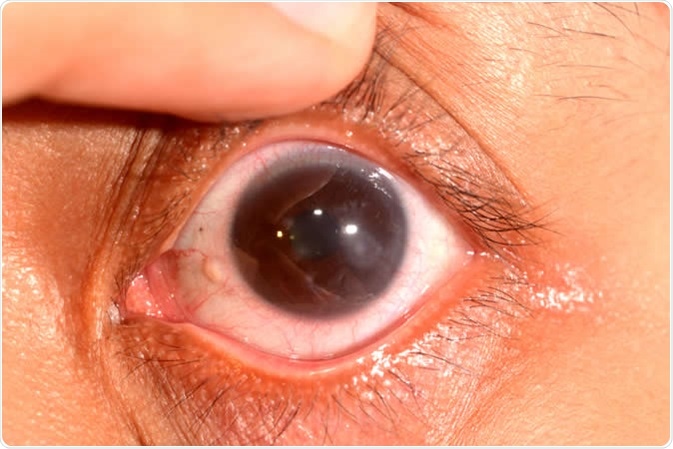Keratitis is a medical term for corneal inflammation. The cornea is a clear dome of epithelium that covers the front of the eye, allowing light to pass through. It covers the iris (colored part of the eye), the pupil and the anterior chamber of the eye.

Close up of the keratitis during eye examination. Image Credit: ARZTSAMUI / Shutterstock
What are the types of keratitis?
Keratitis may be infectious or non-infectious in origin. The infectious type may be due to viruses, bacteria, fungi or even parasites. It is known that infectious keratitis represents a major cause of visual damage and blindness around the world.
On the other hand, non-infectious keratitis could be caused by minor trauma such as overuse of contact lenses or a foreign body that entered the eye. However, even non-infectious keratitis may subsequently become infected, further complicating this condition.
What are the symptoms of keratitis?
Keratitis can produce symptoms such as:
- Redness and pain of the eye
- Excessive tearing
- Pain or irritation on eye opening
- Blurring of vision
- Poor vision
- Inability to tolerate light
- Foreign body sensation in the eye
What causes keratitis?
Keratitis may result from conditions such as:
- Trauma – if a foreign body enters or hits the eye, it may cause corneal inflammation. Secondary infection may occur when microorganisms enter the damaged tissue and colonize it.
- Contact lens-induced infection – if microorganisms colonize the surface of a contact lens or its case, it can act as a vehicle to transfer them to the cornea when it is inserted into the eye. Another way in which contact lenses may promote keratitis is if they are worn for too long.
- Viral infection with herpes simplex or herpes zoster viruses.
- Polluted water containing microorganisms can cause a damaged cornea to become infected, but rarely affect a healthy one.
- Autoimmune conditions like rheumatoid arthritis.
Risk factors for keratitis primarily include contact lens-related factors, such as their overuse, failure to keep contact lenses sterile, wearing them while swimming or sleeping, or protracted periods of their usage. Other risk factor are poor immune function, steroid-containing eye drops and, naturally, eye injury.
Keratitis - Bacterial and Fungal
What are the complications of keratitis?
Keratitis may cause several complications which can endanger the eyesight, such as chronic inflammation of the cornea leading to scarring, chronic viral keratitis, corneal ulceration, reduced visual acuity and, in worst scenarios, complete loss of vision.
How can keratitis be prevented?
Some ways to prevent keratitis include:
- Avoid contact lens-associated risk factors such as prolonged wear, unsterile storage conditions, and failure to take care of them properly or replace them as required;
- Wash your hands before you touch your eyes or the surrounding areas;
- Never rub your eyes if you feel irritation;
- Avoid using eye drops without prescription or beyond the prescribed period.
Further Reading